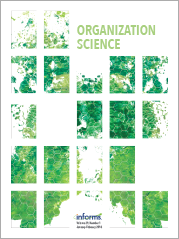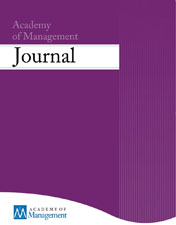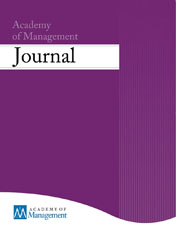Academic articles
Practitioner articles
Working papers
Books
Book chapters
Case studies
Other publications
Subject(s)
Diversity and inclusion; Human resources management/organizational behavior; Management sciences, decision sciences and quantitative methods; Strategy and general management
Keyword(s)
luck, chance models, attribution biases, behavioral strategy, the Carnegie school,
Matthew effect, simulation
Matthew effect, simulation
Volume
14
Journal Pages
1157527
Subject(s)
Human resources management/organizational behavior; Information technology and systems; Strategy and general management
Keyword(s)
Artificial intelligence, AI, implementation challenges, implementation solutions, AI experienced firms, AI newcomers, global survey, diagnostic AI implementation framework, value creation
Volume
66
Subject(s)
Finance, accounting and corporate governance
Keyword(s)
accounting quality, inflation, internal information systems, investment
JEL Code(s)
E22, E52, M41
Volume
76
Journal Pages
101632
Subject(s)
Entrepreneurship; Technology, R&D management
Keyword(s)
Autonomy, teams, ideas, entrepreneurial performance, natural field experiment
Scholars have suggested that autonomy can lead to better entrepreneurial team performance. Yet, there are different types of autonomy and they come at a cost. We shed light on whether two fundamental organizational design choices—granting teams autonomy to (1) choose project ideas to work on and (2) choose team members to work with—affect performance. We run a natural field experiment involving 939 students in a lean startup entrepreneurship course over 11 weeks. The aim is to disentangle the separate and joint effects of granting autonomy over choosing teams and choosing ideas compared to a baseline treatment with pre-assigned ideas and team members. We find that teams with autonomy over choosing either ideas or team members outperform teams in the baseline treatment as measured by pitch deck performance. The effect of choosing ideas is significantly stronger than the effect of choosing teams. However, the performance gains vanish for teams that are granted full autonomy over choosing both ideas and teams. This suggests the two forms of autonomy are substitutes. Causal mediation analysis reveals that the main effects of choosing ideas or teams can be partly explained by a better match of ideas with team members’ interests and prior network contacts among team members, respectively. While homophily and lack of team diversity cannot explain the performance drop among teams with full autonomy, our results suggest that self-selected teams fall prey to overconfidence and complacency too early to fully exploit the potential of their chosen idea. We discuss the implications of these findings for research on organizational design, autonomy, and innovation.
© 2021, INFORMS
Volume
34
Journal Pages
2097–2118
Subject(s)
Finance, accounting and corporate governance
Keyword(s)
aggressive reporting; restatements; returns; compensation; SEM
JEL Code(s)
M40, M41
Volume
98
Journal Pages
153–183
Subject(s)
Entrepreneurship; Strategy and general management; Technology, R&D management
Keyword(s)
startup human capital, STEM labor markets
Volume
2023
Subject(s)
Diversity and inclusion; Strategy and general management; Technology, R&D management
Keyword(s)
gender, status, networks, tie formation, geographic proximity, network proximity, patents
Extant research has shown that it is harder for women than for men to form high-status connections in the workplace. Extending this line of research, we examine how two structural factors – geographic and network proximity – affect men’s and women’s chances of forming high-status connections. Using data on the formation of collaboration ties with star scientists within the R&D laboratories of the forty-two largest pharmaceutical companies between 1985 and 2010, we show that women who are geographically co-located with a “star” colleague are less likely to form a tie with that colleague than male peers who are similarly co-located, and this difference persists irrespective of the star’s gender. Conversely, women benefit more than men do from network proximity, as indicated by the presence of common third-party ties, and this difference widens if the star colleague is also a woman. By illuminating how geographic and network proximity affect the chances of forming high-status connections differently for women than for men, our study goes beyond the notion that women have reduced access to workplace social capital and expands consideration to the structural factors that underpin – amplify or reduce – that disadvantage.
With permission of the Academy of Management
Volume
66
Journal Pages
1501–1528
Subject(s)
Human resources management/organizational behavior; Strategy and general management
Keyword(s)
networks, structural holes, brokerage, innovation, cognitive style, person-network fit, field experiment
Extant research shows that individual cognitive style affects whether employees benefit most from a brokering or a dense network. But do people build the network structure in which they perform best? We address this question by advancing a novel 2-stage explanatory model that explicitly disentangles the network formation process from its performance effects. We hypothesize that Adaptors (i.e., individuals inclined to focus on implementable solutions through commonly accepted and well-defined approaches) perform best when their network spans structural holes. Yet, these same individuals systematically forego opportunities to build relations across structural holes. By contrast, Innovators (i.e., individuals inclined to focus on envisioning creative solutions that break away with established approaches) draw no or even negative performance returns from structural holes. Nevertheless, their inclination is to build ever-new bridging relations. We test and find support for this counterintuitive hypothesis through a randomized longitudinal field experiment enabling us to disentangle empirically both stages of our theorized process model. Our findings help illuminate why people may build networks that hurt their performance, shed a new light on the role of individual cognitive style in shaping network advantage, and bear concrete implications for organizations aiming to leverage networks to enhance employees’ performance.
With permission of the Academy of Management
Volume
66
Journal Pages
1360–1383
Subject(s)
Finance, accounting and corporate governance
Keyword(s)
complexity, FASB Codification, restatements, SEC comment letters
JEL Code(s)
M40, M41, M48, N22
We examine whether the Financial Accounting Standards Board (FASB) Codification made it easier for preparers and auditors to locate relevant accounting guidance. We find that areas of U.S. GAAP with more dispersed and voluminous guidance before the Codification experience a larger post-Codification reduction in restatements. We find a similar decline in SEC comment letter questions referencing areas of U.S. GAAP with more dispersed and voluminous pre-Codification guidance. Our results suggest that before the Codification, preparers and auditors had difficulty in locating the appropriate accounting guidance and that the Codification mitigated this difficulty.
© The Chookaszian Accounting Research Center at the University of Chicago Booth School of Business
Volume
61
Journal Pages
1479–1530
Subject(s)
Management sciences, decision sciences and quantitative methods
Keyword(s)
corporate idea evaluation, blinding, biases
Seeking causal evidence on biases in idea evaluation, we conducted a field experiment in a large multinational company with two conditions: (a) blind evaluation, in which managers received no proposer information, and (b) non-blind evaluation, in which they received the proposer’s name, unit, and location. To our surprise—and in contrast to the pre-registered hypotheses—we found no biases against women and proposers from different units and locations, which blinding could ameliorate. Addressing challenges that remained intractable in the field experiment, we conducted an online experiment, which replicated the null findings. A final vignette study showed that people overestimated the magnitude of the biases. The studies suggest that idea evaluation can be less prone to biases than previously assumed and that evaluators separate ideas from proposers.
© 2023 The Authors. Strategic Management Journal published by John Wiley & Sons Ltd.
Volume
44
Journal Pages
2443–2459



